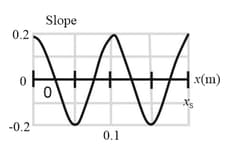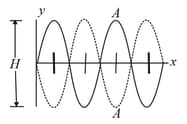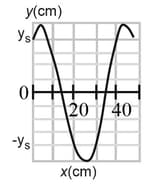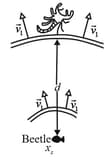Standing Waves and Resonance
Important Questions on Standing Waves and Resonance
Two sinusoidal waves with the same amplitude and wavelength travel through each other along a string that is stretched along the axis. Their resultant wave is shown twice in the figure shown below, as the antinode travels from an extreme upward displacement to an extreme downward displacement in . The tick marks along the axis are separated by , height is Let the equation for one of the two waves be of the form In the equation for the other wave, what are
(a)
(b)
(c)
the sign in front of
A string oscillates according to the equation,
What is the
amplitude
speed of the two waves (identical except the direction of travel) whose superposition gives this oscillation?
What is the distance between nodes?
What is the transverse speed of a particle of the string at the position when ?
A sinusoidal wave travels along a string under tension. The figure shown below gives the slopes along the string at time The scale of the axis is set by What is the amplitude of the wave?

A transverse sinusoidal wave is moving along a string in the positive direction of axis with a speed of . At the string particle at has a transverse displacement of and is not moving. The maximum transverse speed of the string particle at .
(a) What is the frequency of the wave?
(b) What is the wavelength of the wave?
If is the form of the wave equation, what are
(c)
(d)
(e)
(f)
the correct choice of sign in front of
Use the wave equation to find the speed of a wave given in terms of the general function
.
A sinusoidal transverse wave is traveling along a string in the negative direction of an axis. In the Figure shown below shows a plot of the displacement as a function of position at time , the scale of the axis is set by . The string tension is , and its linear density is . Find the
(a) amplitude.
(b) wavelength,
(c) wave speed, and (d) period of the wave.
(e) Find the maximum transverse speed of a particle in the string.
If the wave is of the form what are
(f) ,
(g) ,
(h) and
(i) the correct choice of sign in front of
The speed of a transverse wave on a string is when the string tension is . To what value must the tension be changed to raise the wave speed to
A uniform rope of mass and length hangs from a ceiling.
(a) Show that the speed of a transverse wave on the rope is a function of , the distance from the lower end, and is given by
(b) Show that the time a transverse wave takes to travel the length of the rope is given by
A string along which waves can travel is long and has a mass of . The tension in the string is . What must be the frequency of traveling waves of amplitude for the average power to be
If a wave travels along a string, how much time does any given point on the string take to move between displacements and
Four waves are to be sent along the same string, in the same direction:
What is the amplitude of the resultant wave?
The following two waves are sent in opposite directions on a horizontal string to create a standing wave in a vertical plane:
with in meters and in seconds. An antinode is located at point . In the time interval that point takes to move from maximum upward displacement to maximum downward displacement, how far does each wave move along the string?
A sinusoidal wave is travelling on a string with speed . The displacement of the particles of the string at varies with time according to The linear density of the string is What are
(a) the frequency
(b) the wavelength of the wave?
If the wave equation is of the form what are
(c)
(f) the correct choice of sign in front of
(g) What is the tension in the string?
Two sinusoidal waves of the same period, with amplitudes of and , travel in the same direction along a stretched string. They produce a resultant wave with an amplitude of . The phase constant of the wave is . What is the phase constant of the wave?
A sand scorpion can detect the motion of a nearby beetle (its prey) by the waves the motion sends along the sand surface (in the figure shown below). The waves are of two types, transverse waves travelling at and longitudinal waves traveling at . If a sudden motion sends out such waves, a scorpion can tell the distance of the beetle from the difference in the arrival times of the waves at its leg nearest the beetle. What is the time difference if the distance to the beetle is
What are
(a) the lowest frequency
(b) the second lowest frequency
(c) the third lowest frequency
for standing waves on a wire that is long, has a mass of , and is stretched under a tension of ?
The function, , with in and in , describes a wave on a taut string. What is the transverse speed for a point on the string at an instant when that point has the displacement ?
What is the speed of a transverse wave in a rope of length and mass under a tension of ?
The equation of a transverse wave travelling along a very long string is where and are expressed in centimetres, and is in seconds. Determine
(a) the amplitude
(b) the wavelength
(c) the frequency
(d) the speed
(e) the direction of propagation of the wave
(f) the maximum transverse speed of a particle in the string.
(g) What is the transverse displacement at when
A sinusoidal wave is sent along a string with a linear density of . As it travels, the kinetic energies of the mass elements along the string vary. The figure shown below gives the rate at which kinetic energy passes through the string elements at a particular instant, plotted as a function of distance along the string. The figure shown below is similar except that it gives the rate at which kinetic energy passes through a particular mass element (at a particular location), plotted as a function of time . For both figures, the scale on the vertical (rate) axis is set by . What is the amplitude of the wave?





